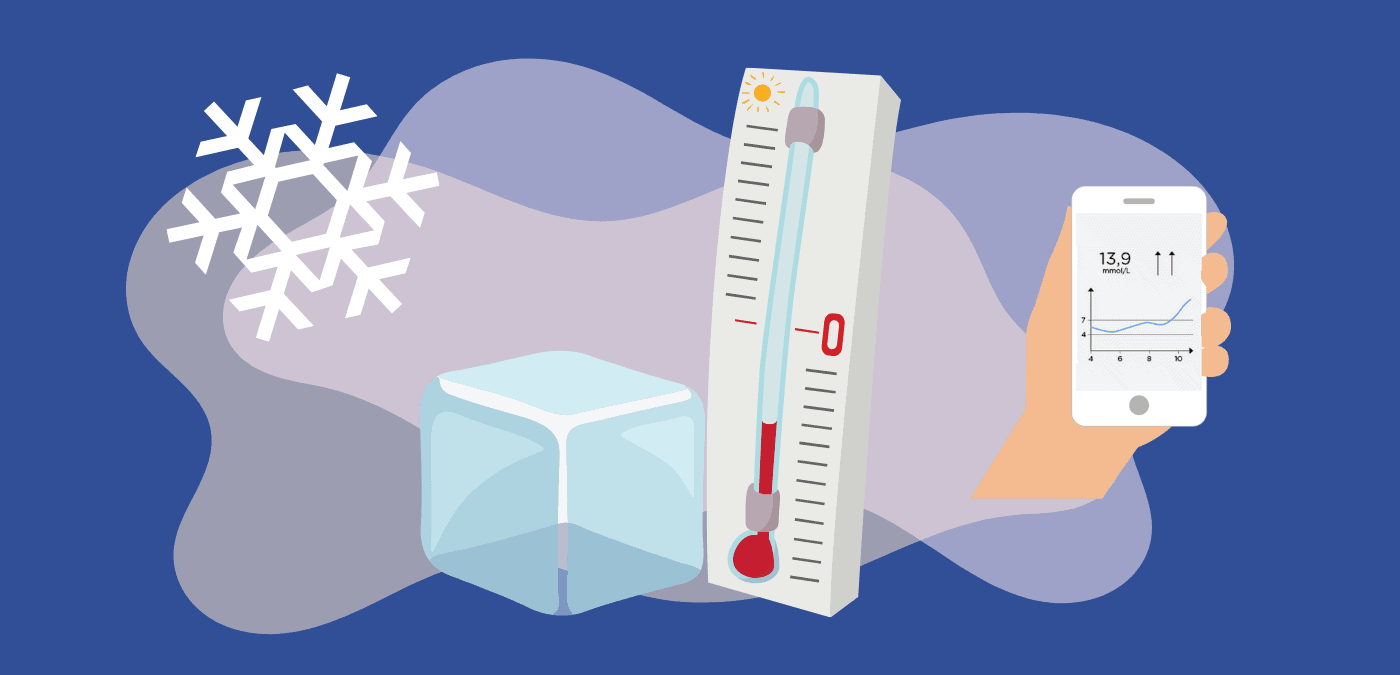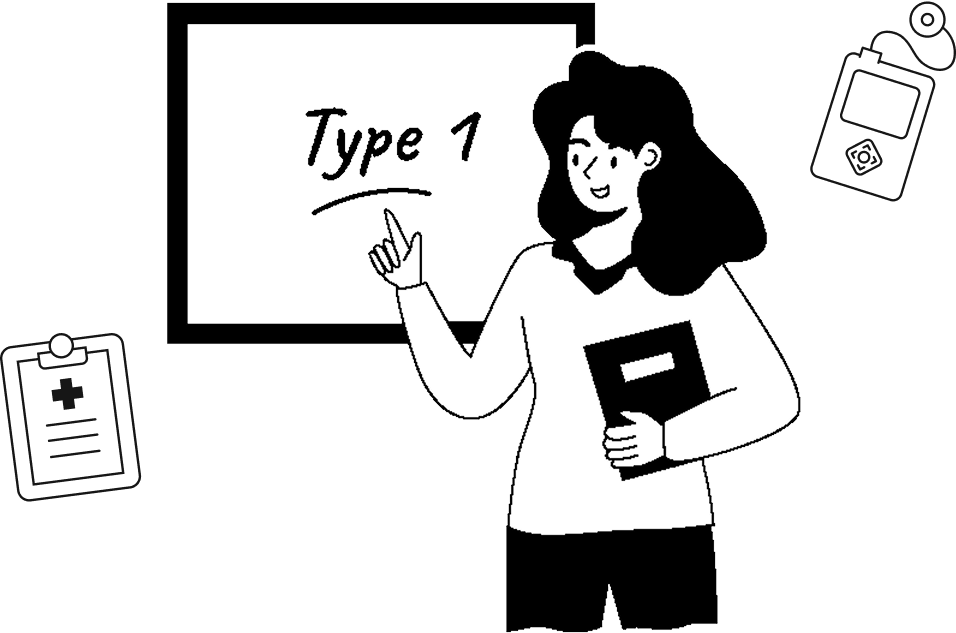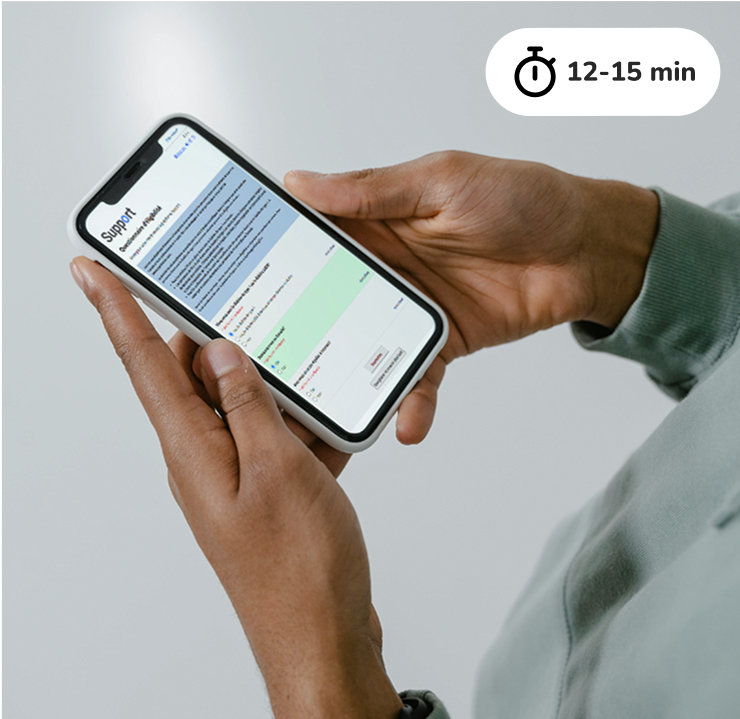Hyperglycemia (blood sugar > 10 mmol/L)—just like hypoglycemia (blood sugar < 4.0 mmol/L)—is one of the many challenges faced by people with type 1 diabetes (T1D). There are many ways to bring down blood sugar levels that are too high (e.g., drinking water, moving around, waiting for blood sugar to return to target levels). When these fail, insulin may be necessary.
Whether you use injections or a pump, the best way to accurately determine the dose of insulin to correct hyperglycemia is using an insulin sensitivity factor, or correction factor.
Let’s break it down together.
How insulin impacts your blood sugar levels
The correction factor is determined based on your insulin sensitivity, i.e. how an insulin unit impacts your blood sugar. This is why it’s also known as the insulin sensitivity factor.
For instance, if you have a correction factor of 5, this means that each unit of rapid-acting insulin administered lowers your blood sugar by an average of 5 mmol/L. Likewise, if you have a correction factor of 2, each insulin unit will lower your blood sugar by an average of 2 mmol/L.
The higher the correction factor, the more insulin sensitive the body is. Therefore, correcting high blood sugar levels will require less insulin.
Conversely, the lower the correction factor, the less insulin sensitive the body is. Therefore, a higher dose of insulin will be required to correct high blood sugar levels.
The correction factor generally limits glycemic fluctuations, such as hypoglycemia as a result of overcorrection.
The correction factor is determined based on the total daily dose of insulin
Your initial correction factor is usually determined by your healthcare team. You can then learn to adjust it on your own.
In most insulin pumps, the correction factor is programmed right at set-up and can be changed at any time. A different value can also be entered for different times of the day and night.
Certain hybrid closed-loop systems, or artificial pancreases, don’t allow the correction factor setting to be changed manually, as it is evaluated and adjusted automatically by the pump algorithm. Ask your healthcare team whether you can adjust this setting in your pump or not.
Your healthcare team will determine your correction factor taking into account your average total daily dose of insulin, including meal and snack boluses, correction boluses and long-acting insulin (for those who use injections) or basal rate (for those who use a pump). The correction factor is calculated according to the following formula:

Example:
If your total daily insulin dose is 31 units, your sensitivity factor will be 3.22 mmol/L (100/31 = 3.22).
The result is generally rounded up. In this example, rounding up to 3.5 will be safer. In fact, the higher the correction factor is, the lower the correction bolus will be.
Determining a correction bolus using the correction factor
Once you know your correction factor, you can use it to determine the correction bolus, or the dose of insulin needed to correct high blood sugar.
For instance, let’s say your blood sugar level is 19 mmol/L and you want to bring it down to 7 mmol/L. If your correction factor is 4 (i.e., one unit of insulin lowers your blood sugar by an average of 4 mmol/L), here’s how you would calculate the correction bolus:
- 19 mmol/L – 7 mmol/L = 12 (difference between your current blood sugar and the target).
- 12 ÷ 4 (your correction factor) = three units of insulin required to correct your blood sugar (correction bolus)
If you are using injections, it is generally recommended to add the correction bolus (three units, in the example above) to the next meal bolus required to cover carbs. On average, rapid-acting insulin stays active for four hours. This means that if you administer a correction bolus in between two meals, its action will pile on the previous meal bolus action, increasing the risk of hypoglycemia. It is therefore preferable to wait three to four hours after an insulin injection before administering a correction bolus.
If you use an insulin pump, correcting high blood sugar is easier and safer. Insulin pumps automatically subtract the amount of insulin that is still acting from the last bolus (active insulin). A different correction factor can also be programmed depending on the time of day (e.g., a higher, safer factor overnight). If your blood sugar isn’t automatically sent to your pump, you’ll need to enter it manually into the pump. The latest hybrid closed-loop systems automatically calculate and deliver insulin to correct blood sugar, without any input required from the user.
Adjusting the correction factor according to your individual needs and to each section situation
Each person has their own correction factor, and it can vary not only over time, but also in the space of a few hours (e.g., you may be more sensitive to insulin at night).
In fact, insulin sensitivity may vary according to various factors, such as:
- Weight variations
- Stress
- Hormonal changes (menstruation, teenage, pregnancy, dawn phenomenon)
- Sick days
- Recent severe hypoglycemia
- Physical activity
- Medications (e.g., cortisone)
- Alcohol consumption
Some of these factors require a lower correction factor (i.e., more insulin) to lower blood sugar (e.g., weight gain, stress, sickness, pregnancy, cortisone), while others require a higher correction factor (i.e., less insulin) to avoid hypoglycemia (e.g., physical activity).
It’s important to check how your correction factor impacts you, or to have it checked. For instance, if you regularly experience hypoglycemia, or if your blood sugar remains high after you’ve administered a correction bolus, your correction factor may need to be adjusted. If your correction bolus is appropriate, your blood sugar should return to target levels after four hours. If it doesn’t, the bolus may have been too large or too small.
Remember that the higher your correction factor is, the less rapid-acting insulin will be required to correct blood sugar. In this case, if your correction boluses often lead to hypoglycemia, you should increase your correction factor.
Conversely, the lower your correction factor is, the more rapid-acting insulin will be required to correct blood sugar. In this case, if your blood sugar remains high after a correction bolus, you should lower your correction factor.
Ask your healthcare team for more information, and refer to our How to Adjust a Correction Bolus sheet.
Want to know more about the correction factor or how to calculate a mealtime bolus? The Support training platform offers a wealth of information to help you live better with T1D.
References :
Hôpital pour enfants. Ratio et correction. [in French] https://www.hopitalpourenfants.com/sites/default/files/PDFs/Diabetes/ratio_et_correction.pdf
Diabète Québec. (2007). Le calcul des glucides. [in French] https://www.diabete.qc.ca/wp-content/uploads/2023/01/Calcul-glucides-nun-10g-4.pdf
Support Plateform.
Written by: Nathalie Kinnard, scientific writer and research assistant
Reviewed by:
- Sarah Haag, R.N., B.Sc.
- Rémi Rabasa-Lhoret, M.D., Ph.D.
- Anne-Sophie Brazeau, P.Dt., Ph.D.
- Amélie Roy-Fleming, P.Dt., M.Sc.
- Michel Dostie, Claude Laforest, Marie-Christine Payette, Jacques Pelletier, patient partners of the BETTER project





